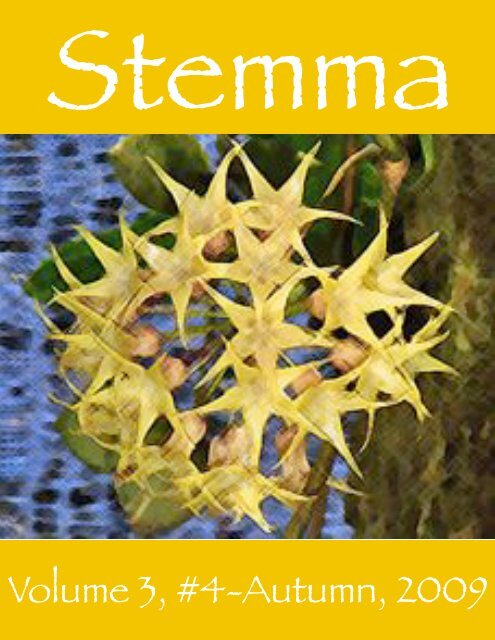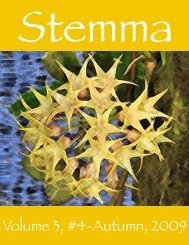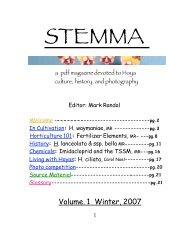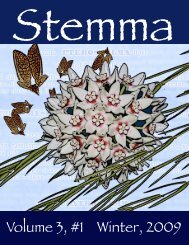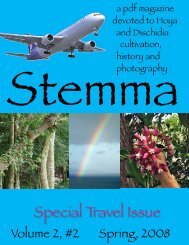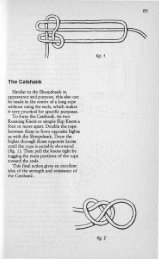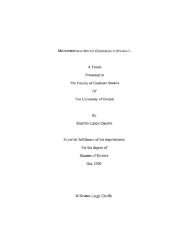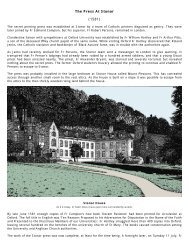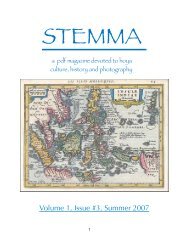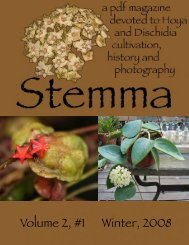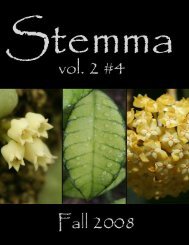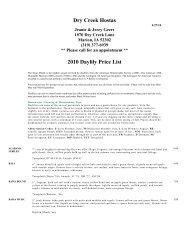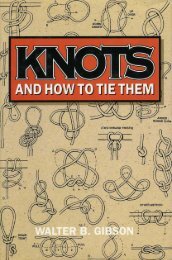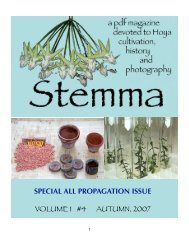Volume 3, Issue #4 - Cubits
Volume 3, Issue #4 - Cubits
Volume 3, Issue #4 - Cubits
You also want an ePaper? Increase the reach of your titles
YUMPU automatically turns print PDFs into web optimized ePapers that Google loves.
Stemma<br />
<strong>Volume</strong> 3, <strong>#4</strong>-Autumn, 2009<br />
1
3 Editor's Note<br />
contents<br />
4 Travel: Land Beneath The Wind: Sabah, Malaysia by Ted Green<br />
9 Bibliography: David Liddle by Mark Randal<br />
13 My 10 Favorite Hoya by Surisa Somadee<br />
20 David Liddle Remembered by Carol Noel<br />
26 Back Page: Hoya sp. IPPS3759 (a.k.a. H. sp. Haruku) by Mark Randal<br />
Editor: Mark Randal<br />
Editor of Dischidia Content: Antone Jones<br />
Technical Consultant: Bobby Fisher<br />
Stemma Godmother: Carol Noel<br />
Availability: Notifications for new issues of Stemma are available through email delivery,<br />
but with a limit of three hundred subscriptions. A few openings are available in the notification<br />
list at this time, please contact the editor at markroy68@yahoo.com. Recent and<br />
back issues will always be available for download at the Stemma website:<br />
www.stemmajournal.com. Posting Stemma for download on unauthorized sites is prohibited.<br />
Usage Policy: Stemma may be distributed freely as a whole by private individuals, but<br />
content and photos remain the intellectual property of the individual contributor and may<br />
not be reproduced separately. Use of any portion of Stemma (including photographic<br />
content) for commercial gain is strictly prohibited.<br />
© Stemma Magazine 2009<br />
2
Editor’s Note<br />
The Hoya world suffered a<br />
great loss this September with<br />
the death of David Liddle.<br />
David, an avid plantsman, has<br />
been active in the collection,<br />
propagation, determination, and<br />
publication of Hoya species for<br />
the last three decades.<br />
David is survived by his wife,<br />
Iris Marie Liddle, with whom he<br />
ran his nursery and plant import/<br />
export business in Mareeba,<br />
Queensland, Australia, and by<br />
his son Adair Liddle.<br />
In this issue a bibliography of<br />
David’s taxonomic publications<br />
and articles can be found on<br />
page 9, and a remembrance of<br />
him written by Carol Noel on<br />
page 20.<br />
In addition to his many other<br />
interests, David was also a talented<br />
photographer. To the right<br />
is a particularly nice photograph<br />
of Hoya macgillivrayi ‘Mt Tozer<br />
rock face, Iron Range, Qld ' IML<br />
0278, taken by David. n<br />
3
Travel<br />
Land Beneath The Wind: Sabah, Malaysia<br />
by Ted Green<br />
Green: Plant Research<br />
Kaaawa, Hawaii<br />
Looking north at Mount Kinabalu, which is over 12,000 ft.<br />
4
Sabah is known as the Land Beneath the Wind, for it escapes the typhoons common<br />
in much of southeast Asia. I only know it as the place of plants and friends.<br />
I am lucky, as I have been able to get there about 8 or 9 times since I first went in<br />
1991. I’ve seen quite a bit of the state, met friends (who are now old friends) and unfortunately,<br />
I’ve also seen the changes. Forestry roads of dirt, dust and rocks are now<br />
paved highways; big buildings stand on reclaimed swamp land and houses and<br />
schools where there were none. That is progress!<br />
To get to Sabah we always go through Manila - cheaper than through Japan or Taiwan<br />
- to break up the long flight (12 hrs) and see friends and maybe see some new<br />
plants in Manila. Luckily, Hawaiian Airlines flies directly from Honolulu to Manila,<br />
and then a day or so later we continue on Cebu Pacific to Kota Kinabalu.<br />
On our most recent trip (April & May, 2009), in Manila we only had time to see an<br />
orchid friend who has 3 farms, about 7 retail outlets and the biggest plant lab in the<br />
Philippines. She has no hoyas unfortunately. It would have taken a whole day to visit<br />
Merlin Sy at Pinoy Plants, for his<br />
place is east of Manila - 2 hours of<br />
terrible traffic. Another field collector<br />
we wanted to see was not home,<br />
so we went directly on to Kota<br />
Kinabula (Known as Jesselton before<br />
the end of WWII), which is a modern<br />
city and the capital of the state<br />
of Sabah, Eastern Malaysia on the<br />
island of Borneo. I say modern for<br />
Jesselton was destroyed in WWII<br />
and has none of the old charm of<br />
Kuching, Sarawak (a large city on<br />
the Malaysian portion of Borneo)<br />
that was spared from the war.<br />
The main purposes of this trip<br />
were to find certain plants, 4 hoyas,<br />
including H. telosmoides, see photo<br />
left) and 3 ground orchids, hopefully<br />
some new, uncollected plants, and<br />
to see the changes at the Kipandi<br />
Butterfly Farm.<br />
5<br />
Left: Hoya telosmoides.
Above: Hoya gildingii.<br />
Right: An intrepid hoya-looker,<br />
expecting rain in “The<br />
Mountain Garden”.<br />
On our first excursion in Sabah my friend<br />
Tony Lamb (I named Hoya lambii after him)<br />
joined Dorothy and I for a long ride down the<br />
west coast to Sipitang were we intended to try<br />
to re-collect Hoya spartiodes.<br />
We had absolutely no luck there- the original<br />
place where I found it is now a school and a<br />
thicket of houses- so we tried a nearby area<br />
with the same type of forest. H. spartioides is<br />
a near-parasite on a certain small tree, and<br />
though we looked at 3,000,000 trees, all with<br />
loads of spiders and dust, we found zero,<br />
zilch, nada. That was an expensive and demoralizing<br />
excursion – a really good first day.<br />
6<br />
Above: Hoya nyhuusiae.<br />
In Kota Kinabula we stayed, as<br />
usual, at Farida’s B&B and made<br />
daily trips out from there. Farida has<br />
always been good at finding a driver<br />
for me - and this time it was a driver<br />
we have had before, Rahim, who<br />
now fancies himself a hoya collector.
Type to enter text<br />
A new, un-named thing we call Hoya sp. “Linus”.<br />
Mt. Kinabalu is about 1-<br />
1/2 hours northeast of<br />
Kota Kinabalu and is at<br />
the northern end of the<br />
Crocker Range. A national<br />
park, it has several easy<br />
trails at about 3,500 to<br />
4,500 ft. elevation. This<br />
time we had Rahim drop<br />
us off at the top of the<br />
Kiau View Trail (getting<br />
smart in my old age) and<br />
walked down. This trail to<br />
me is heaven, with cool,<br />
light breezes and familiar<br />
plants everywhere, although<br />
rain is to be expected<br />
most afternoons.<br />
I wanted to find Hoya gildingii, Hoya nyhuusiae, Hoya telosmoides and a hoya that<br />
Tony calls ‘Mt. White’. We easily found the first three but not Hoya ‘Mt. White’. We<br />
decided to try another place down the range at the same elevation. After leaving the<br />
park we went to Ranau on the<br />
eastern slope of Kinabalu to see<br />
my friend Abas, a music teacher<br />
who collects and sell plants.<br />
Abas was not at home, but his<br />
wife (one of two) showed me<br />
some yellow ground orchids<br />
that I am currently breeding<br />
and studying, but I decided to<br />
pass on buying them. Abas had<br />
no hoyas for sale at this time,<br />
though he usually has some<br />
new and strange ones. Win<br />
some, lose some.<br />
7<br />
The higher elevation H. spartioides.
The next day, Tony Lamb, Dorothy and<br />
I went back to an interesting place – Kipani<br />
Butterfly Farm – that has a good<br />
collection of orchids, hoyas and, of<br />
course butterflies. At about 1,500 ft. elevation,<br />
it is a perfect place for Tony to<br />
keep his new acquisitions and those collected<br />
by Linus, the farm’s manager.<br />
There were new collections of a higher<br />
elevation H. spartiodes, a local Hoya<br />
lasiantha, a clone of H. telosmoides with<br />
larger flower clusters (this species is<br />
common in the that area), and several<br />
unnamed species, including a new unnamed<br />
thing we call Hoya sp. “Linus”.<br />
The next day we went back to an area<br />
nearby Kipani Farm which we call “The<br />
Mountain Garden” where I knew that H.<br />
nyhuusiae grows, and with the hope of<br />
finding Hoya “Mt White” (see photo,<br />
right).<br />
Hoya sp. “Mt. White”? Place your bets!<br />
We did not go to Tenom this trip for<br />
we didn’t think that there would be any changes from 2 years ago. In one week you<br />
can’t do everything!<br />
I still like Sabah, and undoubtedly we will go back again next year. I miss the food,<br />
the people and the plants already. There is just too much unfinished business there that<br />
we want to start.<br />
Ted Green<br />
Green: Plant Research<br />
Kaaawa, Hawaii n<br />
8
Bibliography<br />
compiled by Mark Randal & Paul Forster<br />
published plant names:<br />
David Liddle<br />
Hoya australis R. Br. ex J. Trail ssp. oramicola P. I. Forst. & Liddle<br />
Hoya australis R. Br. ex J. Trail ssp. melanesica P. I. Forst. & Liddle<br />
Hoya australis R. Br. ex J. Trail ssp. rupicola (K. D. Hill) P. I. Forst. & Liddle<br />
Hoya australis R. Br. ex J. Trail ssp. tenuipes (K. D. Hill) P. I. Forst. & Liddle<br />
Madangia inflata P. I. Forst., Liddle & I. M. Liddle (Now Hoya inflata (P. I. Forst. et al.) L.<br />
Wanntorp & P. I. Forst.)<br />
Hoya calycina Schltr. ssp. glabrifolia P. I. Forst. & Liddle<br />
Hoya dennisii P. I. Forst. & Liddle<br />
Hoya flavida P. I. Forst. & Liddle<br />
Hoya magnifica P. I. Forst. & Liddle<br />
Hoya onychoides P. I. Forst., Liddle & I. M. Liddle<br />
Dendrobium discolor Lindl. ssp. incurvata Liddle & P. I. Forster<br />
Monographs and articles (list contributed by Paul Forster):<br />
2009. D.J.Liddle. “Tropical Hoyas”. Subtropical Gardening 16: 26–31.<br />
2008. D.J. Liddle & P.I. Forster. “Notes on some commonly cultivated Hoya species from<br />
Australia, Papuasia and Melanesia: Hoya australis R.Br. ex Traill”. Asklepios 102: 3–15.<br />
2002. P.I. Forster, D.J. Liddle & I.M. Liddle. “Dischidia, Hoya (Asclepiadaceae)”. In R.<br />
Spencer (ed), Horticultural Flora of South-eastern Australia, Flowering Plants, Dicotyledons.<br />
Part 3. 4: 90–103. University of New South Wales Press, Sydney.<br />
9
1999. P.I.Forster, D.J.Liddle & I.M.Liddle. “The genus Hoya R.Br. (Asclepiadaceae: Marsdenieae)<br />
as commonly cultivated in Australia”. Asklepios 78: 18–32.<br />
1998. P.I.Forster, D.J.Liddle & I.M.Liddle. “Diversity in the genus Hoya (Asclepiadaceae –<br />
Marsdenieae).” Aloe 35: 44–48.<br />
1997. P.I.Forster, D.J.Liddle & I.M.Liddle. “Madangia inflata (Asclepiadaceae: Marsdenieae),<br />
a new genus and species from Papua New Guinea.” Austrobaileya 5: 53–57.<br />
1996. P.I.Forster & D.J.Liddle. “Dischidia and Hoya (Asclepiadaceae)”. In A.G.Wilson<br />
(ed) Flora of Australia 28: 231–240. CSIRO Publications: Melbourne.<br />
1995. P.I.Forster, D.J.Liddle & I.M.Liddle. “Taxonomic studies on the genus Hoya R.Br.<br />
(Asclepiadaceae: Marsdenieae) in Papuasia, 7. “ Austrobaileya 4: 401–406.<br />
1994. P.I.Forster & D.J.Liddle. “Type collections of Asclepiadaceae at Herbarium Bogoriense<br />
(BO).” Australian Systematic Botany 7: 507–519.<br />
1993. P.I. Forster & D.J. Liddle. “Asclepiad Profile, 3: Hoya cumingiana Decne.” Asklepios<br />
58: 17–19.<br />
1993. D.J. Liddle. “Hoya megalaster Warburg.” The Hoyan 15(2): 3.<br />
1993. P.I. Forster & D.J. Liddle. “Taxonomic studies on the genus Hoya R.Br. (Asclepiadaceae:<br />
Marsdenieae) in Papuasia, 6”. Austrobaileya 4: 51–55.<br />
1993. P.I. Forster & D.J. Liddle. “Resurrection of Dischidia littoralis Schltr. (Asclepiadaceae).”<br />
Austrobaileya 4: 113–116.<br />
1992. P.I. Forster & D.J. Liddle. “Asclepiad Profile, 2: Hoya imperialis Lindl.” Asklepios<br />
56: 24–26.<br />
1992. D.J. Liddle. “Hoya macgillivrayi F.M.Bailey.” The Hoyan 13(2): 14–16.<br />
1992. P.I. Forster & D.J. Liddle. “Taxonomic studies on the genus Hoya R.Br. (Asclepiadaceae)<br />
in Papuasia, 1–5”. Austrobaileya 3: 627–641.<br />
1991. P.I. Forster & D.J. Liddle. “Variation in Hoya australis R.Br. ex Traill (Asclepiadaceae).”<br />
Austrobaileya 3: 503–521.<br />
1990. D.J. Liddle & P.I. Forster. “The recognition of subspecies in Dendrobium discolor<br />
Lindley (Orchidaceae).” Austrobaileya 3: 319–321.<br />
10
1990. P.I. Forster & D.J. Liddle. “Hoya R.Br. (Asclepiadaceae) in Australia – an alternative<br />
classification. “ Austrobaileya 3: 217–234.<br />
1989. P.I. Forster & D.J. Liddle. “The genus Dischidia (Asclepiadaceae) in Australia.”<br />
Anacampseros 6: 7–12.<br />
1988. P.I. Forster & D.J. Liddle. “Studies on the Australasian Asclepiadaceae. IV. Dischidia<br />
R.Br. in Australia”. Austrobaileya 2: 507–514.<br />
1988. D.J. Liddle. “Hoya macgillivrayi Bailey and Hoya megalaster Warburg, a comparative<br />
study. “ The Hoyan 10: 2–4.<br />
1986. D.J. Liddle. “Preliminary observations on Hoya and Dischidia (Asclepiadaceae) in<br />
Australia”. In Hoya in Australia, pp. 2–37. (ed. P.I.Forster). Queensland Succulent Society:<br />
Brisbane.<br />
11<br />
Illustration of Hoya<br />
callistophylla T. Green<br />
by David Liddle.
Photo montage of Hoya ischnopus and Hoya kenejiana by David Liddle. n<br />
12
My 10<br />
favorite Hoya<br />
by Surisa Somadee<br />
For me, many of my Hoya are strongly connected with the memory of the person who<br />
first shared a cutting of that species or collection with me. Often when I take care of my<br />
plants I happily remember the many friends around the world who have shared plants<br />
with me over the years. I keep them in my heart always, and thought of many of these<br />
friends again while compiling this list.<br />
13<br />
1) Hoya praetorii<br />
This species is very easy to<br />
bring into flower. The red corona<br />
contrasts with the orange<br />
corolla on this particular<br />
clone, which I first received<br />
five years ago from<br />
Maggie Alm in Sweden<br />
(www.hoyor.net). The first<br />
cutting I received from Maggie<br />
died, but when she<br />
learned of this she generously<br />
sent me another cutting,<br />
and this time the cutting<br />
rooted and grew well,<br />
and now I think of Maggie<br />
whenever I look at this<br />
lovely plant. After this wonderful<br />
experience I started to<br />
trade more and more with<br />
people from other countries.
2) Hoya archboldiana<br />
This species has a very<br />
large and very fragrant<br />
flower. The corolla and corona<br />
are both very distinctive<br />
for a Hoya, and the<br />
color of both is very vivid.<br />
This species is a very fast<br />
grower. I grow it on a big<br />
tree where it receives direct<br />
sun for about half of the<br />
day.<br />
14<br />
3) Hoya pandurata<br />
This lovely yellow<br />
lady is from from<br />
Northern Thailand. This<br />
plant always reminds<br />
me of an angel, as the<br />
delicate leaves point<br />
up like little bird<br />
wings. Sometimes I refer<br />
to this Hoya as<br />
“Yellow Bird”.
4) Hoya thailandica<br />
This Hoya is extremely<br />
fragrant and the corona<br />
drips with sweet nectar.<br />
This species comes from<br />
northern Thailand, and I<br />
am very proud to have<br />
her named after my<br />
country.<br />
5) Hoya imbricata<br />
I love her leaves. The stems and leaves of this species<br />
grow flat against tree trunks, and to me the<br />
leaves look like little flying sting rays.<br />
15
6) Hoya mindorensis<br />
This gentle beauty is very easy to grow and flowers all year long. Sometimes I become<br />
busy with work and forget to look at her for some time, but when I do she always greets<br />
me with some lovely, sweet flowers.<br />
16
7) Hoya nummularioides<br />
This sweet little princess blooms only<br />
one time per year in Thailand, in the<br />
winter. It is sweetly fragrant at night and<br />
is densely covered in hundreds of flowers<br />
when she blooms. This species also<br />
comes from Thailand.<br />
17
8) Hoya lasiantha<br />
This species can be found in<br />
the south of Thailand. It is easy<br />
to care for, grows well and has<br />
flowers similar to those of Hoya<br />
praetorii.<br />
18
9) Hoya darwinii<br />
I got this plant from my friend<br />
Merlin Sy during a trip to the<br />
Philippines in 2007. This species<br />
is an “Ant Plant”- meaning<br />
that in nature this plant<br />
often lives symbiotically with<br />
ants.<br />
19<br />
10) Hoya waymaniae<br />
This species has a very<br />
cutely shaped flower-<br />
the corolla makes a perfectly<br />
round ball, and<br />
the dark red corona is<br />
also very lovely. The<br />
peduncles are also very<br />
long. I could not live<br />
without this Hoya! n
David Liddle Remembered<br />
by Carol Noel<br />
David Liddle was a big man - in so many ways.! He looked at the world from a “larger<br />
than life” perspective, and his view was unrestricted to 'this' world, or 'that' world. David<br />
seemed to view life in a holistic way that seemed at times to encompass all things.<br />
David cherished nature and the natural order of life and plants.!He was very keen about<br />
wild life, and prided himself in maintaining a wild habitat around his home. He was<br />
thrilled to drive home at night to find wallabies loping about his yard and to hear the<br />
cockatoos in the gums off the porch at breakfast.<br />
David loved to eat, was<br />
curious about food and<br />
cooking - meals were experiences,<br />
not just fodder.!<br />
Mediocrity and “almost”<br />
had no place in his life.! He<br />
was detached from, and<br />
impatient with, gossip, pettiness<br />
and resentment.<br />
David also loved a good<br />
laugh, and had a witty, dry<br />
sense of humor. He referred<br />
to Hawaii as "The Colonies"<br />
or the Sandwich Isles. Irreverence<br />
was a strong suit<br />
of his.<br />
20
While a stickler for 'truth' and 'correctness' regarding taxonomy, he was wryly amused<br />
when people would get their knickers in a twist about a name, emoting all over the place<br />
and calling each other names.!To David it was simply an unemotional matter of what had<br />
been published, when it had been published and by whom.! Either it was a valid publication<br />
or it wasn’t, regardless of the players involved.<br />
He often admonished me, saying things, like, “it doesn't matter if it is ‘Red Buttons’ or<br />
‘Royal Hawaiian Purple’.! It is H. pubicalyx.! Period."!<br />
David taught me that it is only man who insists on giving the plant a name to satisfy his<br />
own need for order.! The plant doesn't care what it is called.! David did not hesitate to<br />
call a newly received hoya “H. sp XXX” or “H. aff. XXX” until he could complete his<br />
research.!<br />
! David had great respect for the International Code of Botanical Nomenclature.! When<br />
rules are established for continuity and clarity, they are established to be followed.! That<br />
way we are all speaking the same language.<br />
If David had opinions about the identities of unidentified hoyas, he generally kept his<br />
own council.! He aligned himself with scientific research, not with any one person or<br />
group.! He was, perhaps, the leveling factor. At one point David was considered a<br />
“lumper” of Hoya species and at a later time a “separator”.! Honestly?! David did not fit<br />
into either specific camp.!<br />
I will not be alone in missing David Liddle.!There are almost no conversations about<br />
hoyas that don't include the mention of his name.!He has been an arbitrator of disagreements,<br />
an identifier of mysteries and a good friend.! I wish he wouldn’t have left so soon.<br />
_______________<br />
I took a trip to Australia in September<br />
of 2004 to visit David and Iris<br />
Marie at Liddle's nursery in Mareeba,<br />
in Australia’s tropical northeast<br />
coast. It was truly a mindexpanding<br />
experience. Liddle's undoubtedly<br />
has the largest collection<br />
of hoyas in the world.<br />
Left: Iris Marie Liddle. Right and<br />
above, David Liddle.<br />
21
David lived on 12 acres at Emerald Creek (near Mareeba) on the tablelands above<br />
Cairns in Northern Queensland. It is an area of Eucalyptus, Acacias and lots of wild life.<br />
In the area around the Liddle’s nursery people have cleared the land, planted orchards<br />
and are raising cows and livestock. All of this activity has driven much wildlife onto their<br />
property, so a bit of a sanctuary has formed for wallabies, Grey Kangaroo, cockatoos, and<br />
endless bird life. The Liddles raise lorikeets and pheasant; have jungle Chooks (the original<br />
chicken before the chicken became fancy) and peacocks roaming the property. I was<br />
lucky not to meet any of the resident snakes (it was still too cold for them). Then, of<br />
course, there is their special Rainbow lorikeet, Bug-Eye, who mutters to himself constantly.<br />
I swear at one point I heard him say "Piss off, Bug-Eye".<br />
I followed David around like a puppy as he generously shared his knowledge and experience.<br />
Iris Marie (yep…the IML numbers are her initials) really was in charge of the hoya<br />
houses. Iris does the propagating, cutting and labeling for all orders received (that year<br />
they shipped 3500 meters of hoya cuttings….that is over 2 miles of vine). Iris does all of<br />
this and works full time as a teacher for special education children.<br />
David had a devastating encounter with a barbwire fence a few months before my visit.<br />
He was recovering, but the nerve damage was lingering and painful, so he gave me my<br />
tour moving at a brisk limp.<br />
David and Iris Marie had just completed building a huge quarantine house for not only<br />
their own plants, but for other importers as well. Since then, they have added two more<br />
large quarantine houses. Quarantine Houses are extremely well controlled ‘greenhouses’<br />
where imported plants are housed in isolation for 6 months or more (depending on the<br />
plants). As only the governmental agency AQIS (the Australian Quarantine and Inspection<br />
Service) is allowed to enter these buildings, the misting systems are totally automated<br />
and must be maintained from externally located controls. There are few of these facilities<br />
in Australia, the Liddle’s being one of the busiest. Every Friday APHIS comes to inspect<br />
the houses and Iris has to accompany them through their inspection: everyone in moonsuits,<br />
sterile foot baths, the whole 9 yards.<br />
As an example of how this procedure works, let me share my own experiences with<br />
bringing a box of hoya, Plumeria cuttings and Orchid flasks into Australia on that trip. I<br />
brought the box with me on the airplane, and at the airport the Australian Quarantine Inspection<br />
Service knew to expect me and took prompt receipt of the box. The next day I<br />
went to Cairns with David for the inspection. After every single cutting was inspected<br />
with sharp eyes, AQIS took the box to be gassed. We picked the box up in the afternoon,<br />
took them back up to Liddle's quarantine house in Mareeba and unpacked them. After<br />
they had a chance to breathe overnight their ends were wrapped in wet long fiber sphagnum<br />
moss and they were laid on a tray in the misting box. Even with all of this TLC, many<br />
22
of the cuttings lost their leaves- the gassing really stresses them. Those cuttings would stay<br />
in the quarantine house until they produced new viable grow and showed no signs of virus<br />
(approximately 12 weeks). David said that bringing new plants into Australia is very<br />
chancy…there is 20-25% mortality rate because of the gassing.<br />
The photos above show the interior of the shade house, and how the plants are grown.<br />
Each cutting in its pot is allowed to grow up the wire to the frame at the top. The entire<br />
wire can be taken down with the plant for cutting or trimming. The plants are grown in<br />
related groups, similar species grown together. It is amazing to see a whole cluster of a<br />
single species of, say, H. macgillivrayi, but perhaps 6 or more different clones.<br />
The shade houses are covered with 80% shade cloth, and even within that there are<br />
darker and lighter areas. The hoyas appear to like the fluctuations of temperatures (they<br />
have it in the wild) as well as the moving light of the sun rising and setting. Daytime<br />
temps are, of course, higher than nighttime. Sometimes it is downright cool at night. For<br />
the "heat lovers" there are warmer spots in the shade house.<br />
The automatic sprinklers went on at 4 a.m. for an hour and the following day the rounds<br />
are made to make sure all of the sprinkler heads were working. General humidity is about<br />
50%, but there are wetter and drier areas for certain plants.<br />
23
When cuttings are made (generally 4-5 node<br />
for the smallest hoyas with short internodes,<br />
others depending upon the quantity available,<br />
but 2 to 3 node is generally used), the ends are<br />
dipped in rooting hormone, wrapped in damp<br />
long fiber sphagnum moss and then put into<br />
about a 1.5" deep round pot that has soil in the<br />
bottom. These round tube-pots go into a tray<br />
and are then put into a propagation box. The<br />
propagation boxes have a tray approximately 4"<br />
deep full of large perlite. The tray with the cuttings is put on top of this bed of perlite and<br />
the plastic sides of the "box" are zipped shut. This box is about 2'x2'x15'. Misters are<br />
rigged along the top of this "box" and they go on for about ten seconds every 3 hours. The<br />
light is low. The temperature is cool and the humidity is high (because of the water that<br />
collects in the tray of perlite). As a result, the cuttings are not stressed at all and can concentrate<br />
on forming root systems.<br />
Once the roots are formed, any loose Sphagnum Moss is removed without disturbing<br />
the roots, and the rooted cuttings are transplanted into the standard potting mix.<br />
The potting mix Liddle's use is: volcanic gravel similar to, but smoother than, cinder;<br />
organic matter (peat); #3 perlite; and small amount of 14-14-14 slow-release fertilizer.<br />
Most of the hoyas were growing in 4" plastic pots, some of the larger ones in 5" pots.<br />
When a pot was squeezed and there was still "give" in the pot…not time to pot up to the<br />
bigger size. Conversely, when the pot is squeezed and there is no give…time to pot up.<br />
Every single hoya in the Liddle collection has an IML # assigned to it, as well as collection<br />
data. Whether they are the hoyas that David has collected himself or those received<br />
from other sources, it is noted in detail. I can see where this is a key in tracking down the<br />
identification of an acquired plant. Each and every pot was tagged with an ID.<br />
The Liddle's had copies of holotypes and other archival data useful for identifying<br />
plants. David also traveled to herbariums to perform research, and worked closely with<br />
Dr. Paul Forster and other botanists and collectors.<br />
I was able to participate fully in making my order happen! With my list in hand and labels<br />
made out, David and Iris collected the cuttings that I tagged and put into a tub of<br />
water. Once the entire cutting operation was done, each cut was inspected and the<br />
nodes, crevices, backs of leaves etc. brushed with a toothbrush. The entire batch was<br />
hosed down, soaked, inspected a second time and then put into the quarantine house for<br />
the night awaiting inspection.<br />
24
At AQIS inspection, the box of cuttings were spread out upon a stainless steel table.<br />
With a lighted magnifying glass about 10" (25cm) in diameter, each cutting was inspected<br />
under the glass for bugs, fungus or even an attitude! The inspected cuttings were passed<br />
on to another inspector who looked the cutting over and then, finally, into the box they<br />
went! The box was sealed, taped, blessed and ready for the trip. All of this procedure was<br />
charged for by the Australian Quarantine Inspection Service and it is not cheap. They are<br />
very pleasant, very thorough and very good.<br />
_________________________<br />
During my visit we ate like kings (both David and Iris are great cooks), drank gallons of<br />
Dark & Stormies (Bundaberg ginger beer spiked with Bundaberg rum) that go down like<br />
water and pack quite a punch, and polished off many a bottle of champagne…the perfect<br />
libations for a spectacular Australian sunset seen from the potting house!<br />
I consider myself so fortunate to have seen the nursery and its inner workings when I<br />
did. It was truly an inspiring visit, and I have since put many of the Liddle’s practices into<br />
place in my own nursery.<br />
Farewell, David! n<br />
P.S. In talking with Iris Marie Liddle over the past few days, I decided to pass along a few details<br />
regarding the current workings of Liddle’s nursery.<br />
Iris, as mentioned above, has an outside career working with special needs children. She has<br />
cut back on those hours so as to dedicate more time to the day to day running of the nursery,<br />
working with the AQIS, and tending the animals that live on the Liddle’s property. David and<br />
Iris’s son Adair is helping out for now, but he also works outside of the nursery.<br />
In David’s absence orders are taking longer to ship and emails longer to be responded to, so patience<br />
is appreciated! n<br />
25
Back page<br />
Hoya sp. IPPS3759<br />
aka H. sp. “Haruku”<br />
(Often misspelled as “H. sp. Haraku”)<br />
Other labels: H. sp. GPS 3759<br />
Country of Origin: Haruku Island in Indonesia, near Ambon.<br />
Hoya section: Acanthostemma (Blume) D. Kloppenburg.<br />
Related/Similar Species: Hoya kentiana C. M. Burton, H. wayetii D. Kloppenburg, H. inconspicua Hemsl.<br />
Flower Color: reddish purple.<br />
Flower Size: almost 1cm when pressed flat, about .5cm when fully open and revolute,<br />
measured across.<br />
Flower Form: revolute.<br />
Scent: Similar to that of burnt sugar syrup, caramel.<br />
Leaf size: from 5-12cm (2-4.5”) long, from 1.75 to 2.25cm (3/4” to 7/8”) wide.<br />
Collector: D. Hoetmer.<br />
Collector’s note: “Molukken Haruku (between Ambon and Saparua) in fallen palm tree at<br />
the beach, with small red flower.”<br />
Water Requirements: high, does not like to dry out completely.<br />
Light Requirements: can tolerate some direct sun, seems to prefer bright indirect light.<br />
Cultivation notes: a vigorous grower and early bloomer, this plant can be grown on a<br />
small trellis or as a hanging basket.<br />
26


